THE JOY(S) OF COMPOSTING
Dinosaurs and Snake Eggs, and More
Most benefits of compost are well-known: it takes out your “garbage,” it fertilizes your plants, it’s teeming with beneficial microorganisms, yadda, yadda, yadda. One too often overlooked plus for compost is the thrill of discovery, discovery of things other than compost in the pile.
Discovery might range from the mundane to the sublime. Among the mundane discoveries is that glint of a lost kitchen fork as it emerges from within the chocolatey pile. Same for the favorite vegetable peeler or the lost stainless steel coffee strainer.
More towards the sublime end of the spectrum would be the dinosaur that surfaced as I was turning a pile a few years ago. A dinosaur! Yes, a small, plastic one that got there from who knows where.
More seriously sublime was the clutch of about three dozen soft, white eggs about the size of quail eggs that came into view as my pitchfork lifted a clump of compost for turning into the adjacent compost bin. Turns out they were snake eggs, those of a black rat snake. 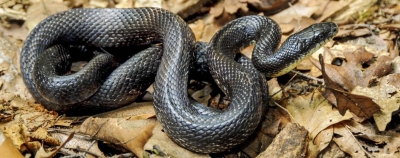 Some snakes give birth to live young, ready to crawl; black rat snakes lay eggs.
Some snakes give birth to live young, ready to crawl; black rat snakes lay eggs.
I put a few of those snake eggs into a terrarium along with some compost to see if they would hatch. For the uninitiated (me), it’s an eerie sight to see such a traditionally maligned creature emerge from such a welcome, traditional symbol of springtime rebirth. Baby black rat snakes are not black. Instead, bands of dark and light gray run across their backs.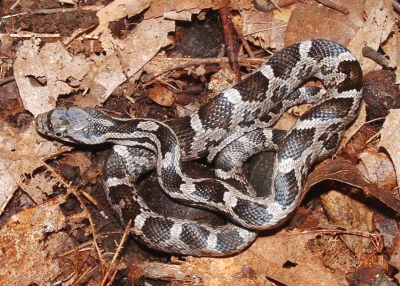
Another time, while turning my compost pile, I accidentally disturbed a mating pair of black rat snakes in flagrante delicto.
Ducks and Grubs, and More
White grubs occasionally turn up in my pile, but a couple of days ago, one of my piles was home to at least two dozen of the C-shaped, creamy white grubs resting within. 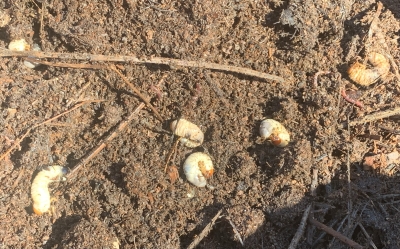 On the chance that they were grubs of Japanese beetles, I started picking them out and yelling “Quack, quack.” No, I hadn’t lost my mind; I was calling the ducks over for a treat of beetle grubs. They dashed for each tossed grub as it hit the ground.
On the chance that they were grubs of Japanese beetles, I started picking them out and yelling “Quack, quack.” No, I hadn’t lost my mind; I was calling the ducks over for a treat of beetle grubs. They dashed for each tossed grub as it hit the ground.
And then a mouse, disturbed in my compost turning, made a dash out of the bin and across the lawn. A mouse in a compost bin is not that surprising, although the construction of my bins and my two dogs are pretty good at keeping mice at bay. (I make efforts to limit mouse populations because they can spread diseases such as hantavirus, salmonella, and lymphocytic choriomeningitis.)
One of the ducks took a break from grub hunting to grab the mouse which, judging from the chase the other ducks gave the lucky duck, is more of a gourmet duck food than even the grubs. Soon only the mouse’s tail was hanging out the duck’s beak, and then the mouse was down the gullet. Here’s a video I took of the Duck eating mouse
But Does Compost Really Need Turning?
You might wonder: What’s with all this compost turning? Each of my compost bins holds a half to three-quarters of a ton of compost, each pile gets turned once, and I have a number of piles. Is it worth all that work?
Turning a compost pile lets me see how the process is chugging along. I keep a record of when a pile was built, and then months later, when it’s turned, how far along it is to being ready to use. After I turn a pile a make a guesstimate of percent decomposition, which is accurate enough for me to know about when it will be ready for spreading.
Turning a pile also lets me get a look at the compost-to-be and then to make any adjustments that might be necessary. I’ll lightly hose down every few inches of turned material, enough to make the ingredients glisten. Anything looking exceptionally dry gets extra water. Occasionally, part of the pile is too wet. I fluff it up as I flip it over into the adjacent bin. Parts of the pile might be compressed into a dense mat. Throwing it into the adjacent bin might be enough to loosen it up; if not, I pick at it with the tines of the pitchfork.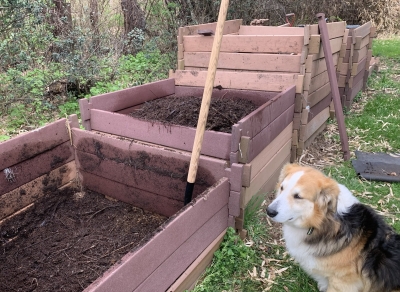
Turning the pile also mixes up the ingredients more than when the pile was built. Each part of the pile, then, gets new neighbors in the form of new ingredients and new microorganisms.
Turning a compost pile is not absolutely necessary, although it’s probably best to leave a bin intact longer if the pile isn’t turned. On the other hand, I find turning a compost pile not only interesting, but also enjoyable and nice exercise.

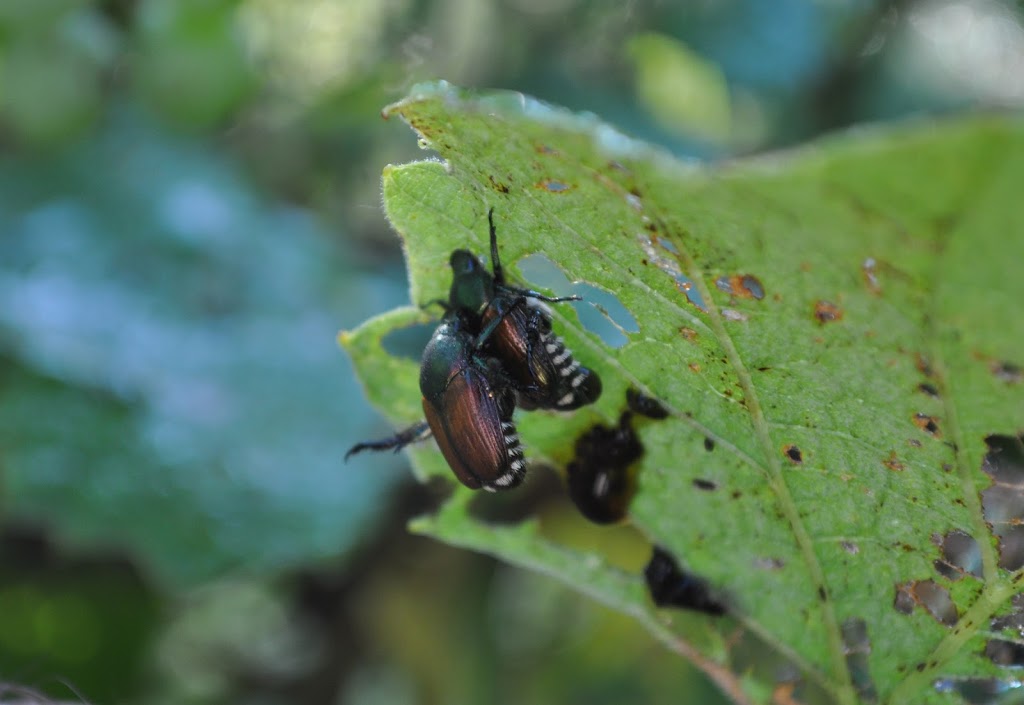

WOW!
I never found snakes in compost, wasp, fire ants & red worms all the time.
Always spiders.
I am also a compulsive composter and have a large plastic composter for kitchen wastes, a pile in one corner of my yard for garden clippings, and a large leaf pile near our large oak tree which I call my compost “meat loaf” from it’s long, rectangular shape. I, too, find interesting animals in my compost piles including a resident garter snake who likes the warmth of the pile. I laughed when I read about all the kitchen tools you discovered in your piles; I have had the same experience.
I love reading your blogs and always learn more about gardens from them.
Thanks.
Thank you, Cynthia Fisher, for graciously accomodating in your compost heap ‘my’ garter snakes brought into the house by my innocent 3 yr old female cat w/ enthusiasm, usually unharmed.
One spring I found a cache of black walnuts all cleaned and ready to crack and eat.
A well-trained squirrel, no doubt.
One year when I started turning my compost pile a large opossum and its kids came popping out, they were living under some pieces of old firewood at the bottom. Needless to say I was startled to the extreme.
Hi Lee:
I noticed the other day from a message of 2021, that you were sort of retiring from your garden blogs and expert advice you have given many, many folks. Now I am reading your recent blog on one of your expert advice’s “composting”.
As I read your sort of retirement notice as of last year I was not quite sure if I lost a friend or what happened.
I do understand time passes and one has to slow down. I do respect your blogs and have received mush information from them.
Do hope you are well and continue your gardening advice.
Many Thanks,
Ken
Thanks Ken. A lot of people misinterpreted my discontinuing a syndicated column I wrote for 30+ years for Associated Press as retirement. But I was and am continuing my other writing, which includes my book about growing figs in cold climates that came out last October, and a book about fruit illustrations done for the USDA about 100 years that will be out this October. Also, some other books in the pipeline, lectures, webinars, occaional nespaper of magazine articles, consulting, and, of course, my blog. Stay tuned!
Waiting for the garter snakes to begin to arrive in my house via my little female torbie who collects but doesn’t kill. They start small but as summer progresses, increase in size! I took about 10 to a nearby compost heap last summer. I’m known as the Snake Lady by this neighbor.